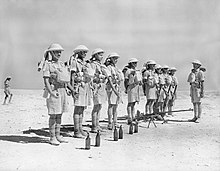
Back مضادات الدروع Arabic Противотанкова отбрана Bulgarian Combat antitanc Catalan Panzerabwehr German Αντιαρματικό όπλο Greek Kontraŭtanka militado Esperanto Combate antitanque Spanish Tankitõrje Estonian Tankeen aurkako gerra Basque جنگافزار ضدتانک Persian
This article has multiple issues. Please help improve it or discuss these issues on the talk page. (Learn how and when to remove these template messages)
|

Anti-tank warfare originated during World War I from the desire to develop technology and tactics to destroy tanks. After the Allies deployed the first tanks in 1916, the German Empire introduced the first anti-tank weapons.[1] The first developed anti-tank weapon was a scaled-up bolt-action rifle, the Mauser 1918 T-Gewehr, that fired a 13.2 mm cartridge with a solid bullet that could penetrate the thin armor used by tanks at that time and destroy the engine or ricochet inside, killing occupants.[2] Because tanks represent an enemy's strong force projection on land, military strategists have incorporated anti-tank warfare into the doctrine of nearly every combat service since. The most predominant anti-tank weapons at the start of World War II in 1939 included the tank-mounted gun, anti-tank guns and anti-tank grenades used by the infantry, and ground-attack aircraft.

Anti-tank warfare evolved rapidly during World War II, leading to infantry-portable weapons such as the Bazooka, anti-tank combat engineering, specialized anti-tank aircraft and self-propelled anti-tank guns (tank destroyers). Both the Soviet Red Army and the German Army developed methods of combating tank-led offensives, including deployment of static anti-tank weapons embedded in in-depth defensive positions, protected by anti-tank obstacles and minefields, and supported by mobile anti-tank reserves and by ground-attack aircraft.

Through the Cold War of 1947-1991, the United States, Soviet Union and other countries contemplated the possibility of nuclear warfare. While previous technology had developed to protect the crews of armored vehicles from projectiles and from explosive damage, now the danger of radiation arose. In the NATO countries, little if any development took place on defining a doctrine of how to use armed forces without the use of tactical nuclear weapons. In the Soviet sphere of influence the legacy doctrine of operational maneuver was theoretically examined to understand how a tank-led force could be used even with the threat of limited use of nuclear weapons on prospective European battlefields. The Warsaw Pact arrived at the solution of maneuver warfare while massively increasing the number of anti-tank weapons. To achieve this, Soviet military theorists such as Vasily Sokolovsky (1897–1968) realized that anti-tank weapons had to assume an offensive role rather than the traditionally defensive role used in the Great Patriotic War (1941–1945), becoming more mobile. This led to the development of improved guided anti-tank missiles, though similar design work progressed in Western Europe and the United States.
Both sides in the Cold War also recognized the utility of light anti-tank weapons, and this led to further development of man-portable weapons for use by infantry squads, while heavier missiles were mounted on dedicated missile tank-destroyers, including dedicated anti-tank helicopters, and even heavier guided anti-tank missiles launched from aircraft. Designers also developed new varieties of artillery munitions in the form of top-attack shells, and shells that were used to saturate areas with anti-armor bomblets. Helicopters could be used as well to rapidly deliver scattered anti-tank mines.
Since the end of the Cold War in 1992, new threats to tanks and other armored vehicles have included remotely detonated improvised explosive devices (IEDs) used in asymmetric warfare and weapon systems like the RPG-29 and FGM-148 Javelin, which can defeat reactive armor or shell armor. Both those weapon systems use a tandem warhead where the first stage of the warhead activates the reactive armor, and the second stage defeats the shell armor by means of a high-explosive anti-tank (HEAT) shaped charge.
During the Ukraine war of 2014- , drones and loitering munitions have attacked and destroyed tanks.
- ^ "WW1 Anti-Tank rifles". Retrieved 10 October 2014.
- ^ Maj. Frederck Myatt M.C., Modern Small Arms, Crescent Books, New York, NY, 1978, pp,228–29
© MMXXIII Rich X Search. We shall prevail. All rights reserved. Rich X Search